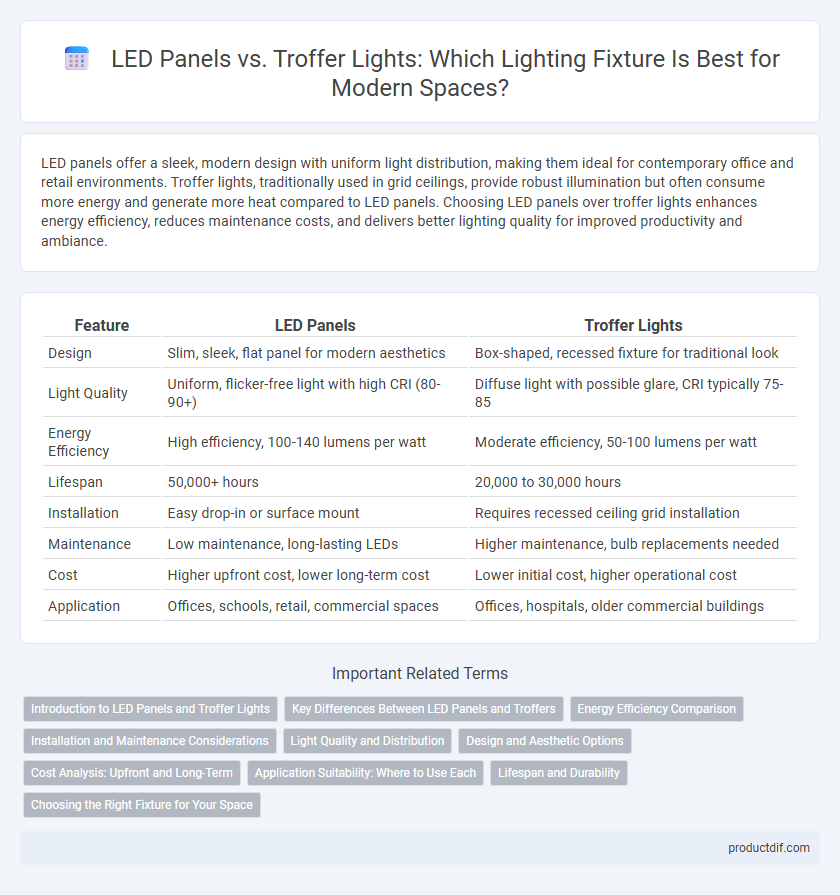LED panels offer a sleek, modern design with uniform light distribution, making them ideal for contemporary office and retail environments. Troffer lights, traditionally used in grid ceilings, provide robust illumination but often consume more energy and generate more heat compared to LED panels. Choosing LED panels over troffer lights enhances energy efficiency, reduces maintenance costs, and delivers better lighting quality for improved productivity and ambiance.
Table of Comparison
| Feature | LED Panels | Troffer Lights |
|---|---|---|
| Design | Slim, sleek, flat panel for modern aesthetics | Box-shaped, recessed fixture for traditional look |
| Light Quality | Uniform, flicker-free light with high CRI (80-90+) | Diffuse light with possible glare, CRI typically 75-85 |
| Energy Efficiency | High efficiency, 100-140 lumens per watt | Moderate efficiency, 50-100 lumens per watt |
| Lifespan | 50,000+ hours | 20,000 to 30,000 hours |
| Installation | Easy drop-in or surface mount | Requires recessed ceiling grid installation |
| Maintenance | Low maintenance, long-lasting LEDs | Higher maintenance, bulb replacements needed |
| Cost | Higher upfront cost, lower long-term cost | Lower initial cost, higher operational cost |
| Application | Offices, schools, retail, commercial spaces | Offices, hospitals, older commercial buildings |
Introduction to LED Panels and Troffer Lights
LED panels offer sleek, energy-efficient lighting with a slim profile designed for seamless ceiling integration, commonly used in modern commercial and office environments. Troffer lights, traditionally fluorescent fixtures, are rectangular or square lights that fit into modular dropped ceilings, providing uniform illumination for large spaces. Upgrading from troffers to LED panels improves energy savings, reduces maintenance costs, and enhances light quality in standardized ceiling grids.
Key Differences Between LED Panels and Troffers
LED panels offer a slim, flat design that provides uniform light distribution with high energy efficiency, making them ideal for modern office and commercial spaces. Troffer lights, typically recessed into ceiling grids, feature a more traditional box shape and use fluorescent or LED tubes, often producing higher glare and less even illumination. Key differences include LED panels' thinner profile and longer lifespan compared to the bulkier troffers, which can affect installation flexibility and maintenance costs.
Energy Efficiency Comparison
LED panels consume up to 50% less energy compared to traditional troffer lights, significantly reducing electricity costs in commercial and office spaces. The advanced diodes in LED panels offer higher lumen output per watt, resulting in superior illumination with lower power usage. Troffer lights, often using fluorescent bulbs, typically have lower energy efficiency and shorter lifespans, making LED panels a more sustainable choice for long-term energy savings.
Installation and Maintenance Considerations
LED panels offer simpler installation with surface-mount or recessed options that fit standard ceiling grids, reducing labor time compared to troffer lights. Troffer lights often require more complex wiring and mounting adjustments, increasing installation effort and potential downtime. Maintenance for LED panels is streamlined due to longer lifespans and fewer component replacements, while troffers may demand more frequent bulb and ballast changes, raising ongoing service costs.
Light Quality and Distribution
LED panels provide uniform light distribution with minimal glare, creating a balanced and comfortable lighting environment suitable for offices and commercial spaces. Troffer lights typically feature recessed fixtures with diffusers, offering good directional lighting but sometimes resulting in uneven light spread and shadows. High CRI values in LED panels enhance color accuracy, while troffers may vary, impacting overall light quality depending on the diffuser type and lamp used.
Design and Aesthetic Options
LED panels offer sleek, thin profiles that seamlessly integrate into modern ceilings, providing uniform light distribution and a clean, minimalist aesthetic. Troffer lights typically feature a bulkier frame with visible louvers or diffusers, which may limit design versatility but suit traditional commercial interiors. The choice between LED panels and troffers hinges on desired aesthetics, with LED panels favoring contemporary, streamlined spaces and troffers aligning with classic office designs.
Cost Analysis: Upfront and Long-Term
LED panels generally have a higher upfront cost compared to traditional troffer lights but offer significant long-term savings through reduced energy consumption and lower maintenance expenses. Troffer lights, while initially more affordable, typically incur higher operational costs due to their less efficient lighting technology and more frequent replacement needs. Investing in LED panels results in quicker return on investment by decreasing total cost of ownership over time.
Application Suitability: Where to Use Each
LED panels excel in modern office spaces and commercial settings requiring sleek, uniform lighting with high energy efficiency and minimal glare. Troffer lights are ideal for traditional drop ceilings in schools, hospitals, and retail environments, offering versatile illumination with easy retrofit options. Selecting between LED panels and troffer lights depends on ceiling type, desired aesthetic, and specific lighting needs of the installation area.
Lifespan and Durability
LED panels offer a lifespan of approximately 50,000 hours, significantly surpassing troffer lights, which typically last around 30,000 to 40,000 hours. Constructed with robust materials and designed for low-heat emission, LED panels provide enhanced durability and reduced maintenance costs compared to traditional troffer lighting fixtures. Their solid-state design minimizes failure points, making LED panels a long-lasting and reliable choice for commercial and residential lighting applications.
Choosing the Right Fixture for Your Space
LED panels offer uniform light distribution and energy efficiency, making them ideal for modern office environments and commercial spaces requiring minimal glare. Troffer lights, commonly used in drop ceilings, provide strong illumination with a variety of sizes and wattages, suitable for larger areas or settings demanding higher brightness levels. Choosing the right fixture depends on ceiling type, desired brightness, energy consumption, and aesthetic preferences to ensure optimal lighting performance and cost-effectiveness.
LED Panels vs Troffer Lights Infographic

 productdif.com
productdif.com